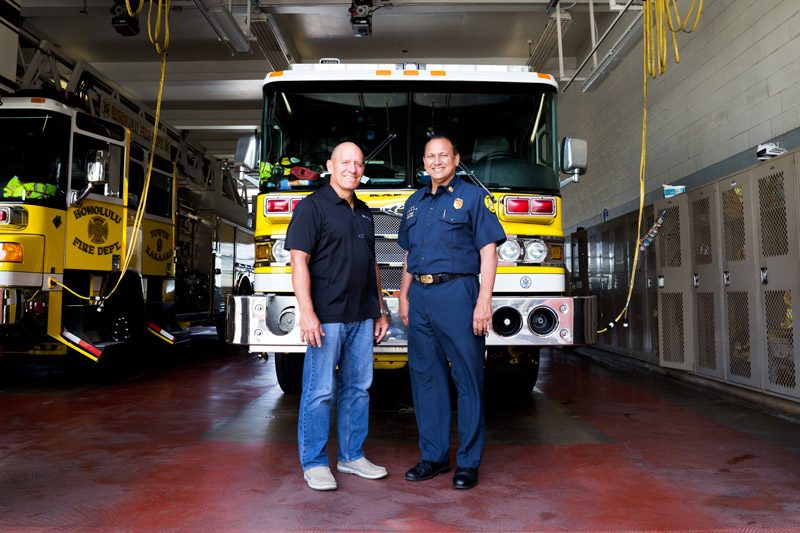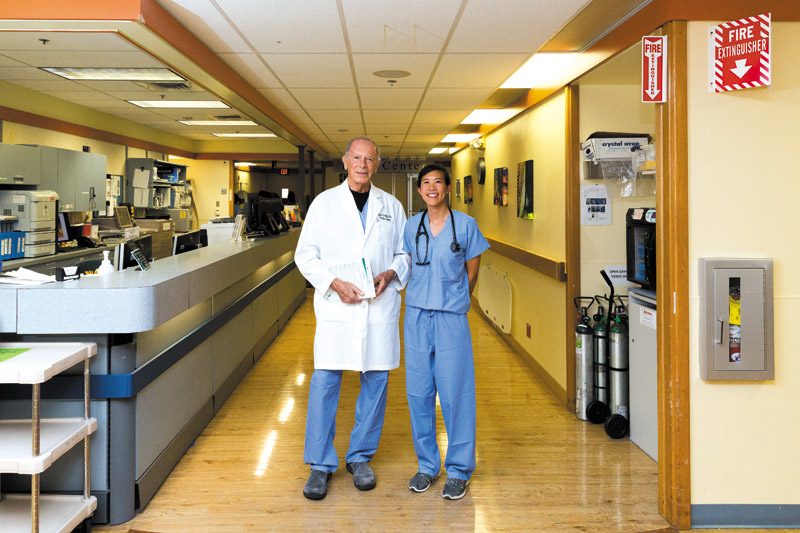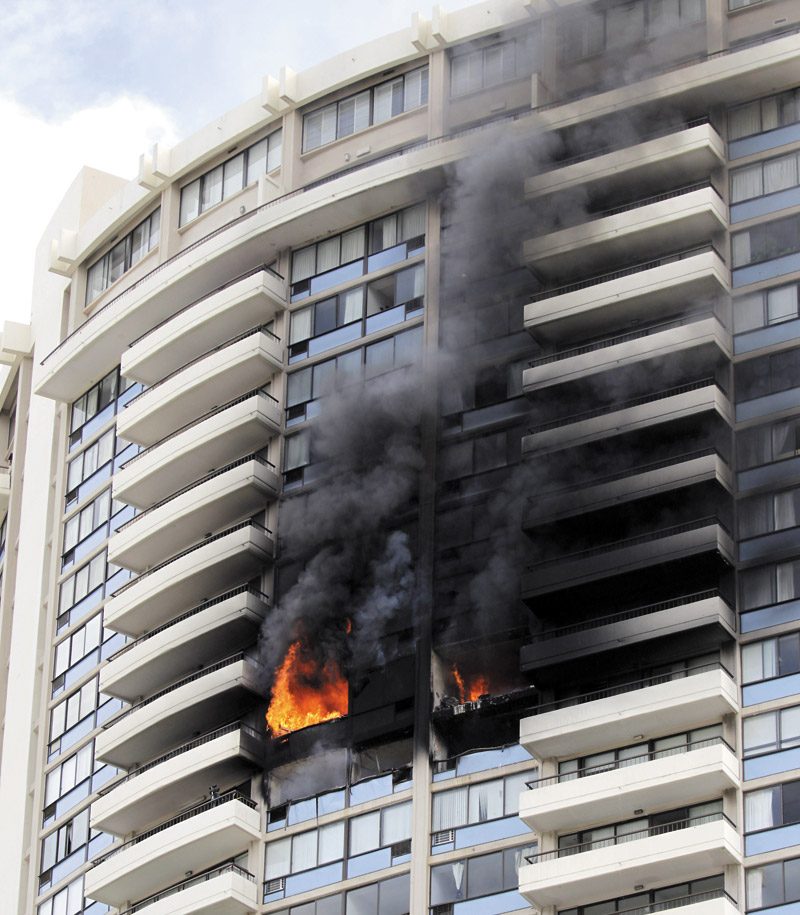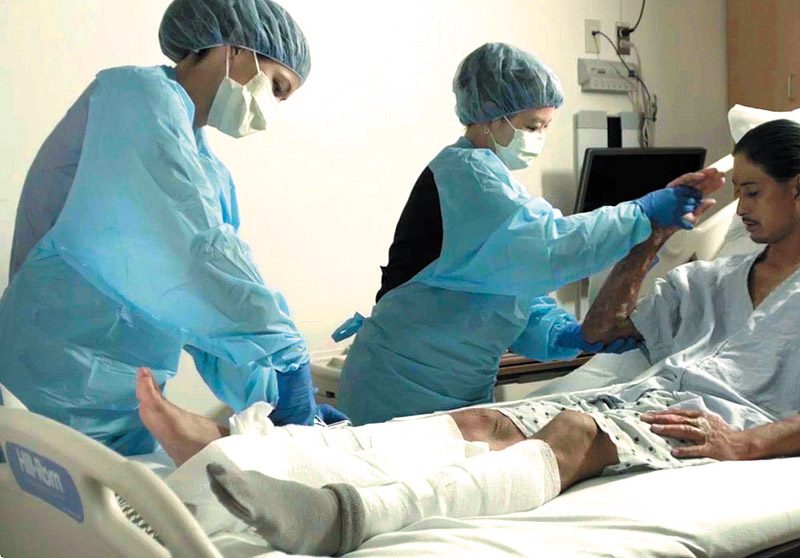Front And Center

Kenneth Silva, retired Honolulu Fire Department chief, with current fire Chief Manuel Neves at Kaka‘ako Fire Station
There may be no greater gift, or curse, than fire. Without it, there would never have been an Industrial Revolution, men on the moon or migration beyond the tropical zones. It is at the heart of every great leap forward man has ever made.
But its duality comes at a cost, for only one thing can bring down a 1,000-year-old forest in mere days with the slightest spark. When religions want to draw non-believers into the fold, it is the threat of eternal damnation in flames that proves to be their most compelling argument. And despite millenia spent learning to tame its force, fire can elude its prison in a flash and bring ruin to all in its path, as we saw most recently at the Marco Polo highrise in Honolulu.
This is why we celebrate those brave men and women who defy fire and batter it back into submission. Monuments are built to the heroism of firefighters, and movies and television shows celebrate their courage — with good reason: They are willing to face the fears that leave the rest of us quivering at the mere thought.
But once the flames are doused, the axes cleaned off and hoses rolled away, what happens to the victims of its destructive touch? This is where the Straub Burn Center takes over. While fighting the fire may have taken hours or even days, it will be months or years before its casualties are ready to rejoin society.

Dr. Robert Schulz, co-founder and medical director of the Straub Burn Center, with Perry Lai, RN
Up until the early 1980s, there was no dedicated burn center in the Islands. The closest one was in California, and to get there you needed an important connection. Fortunately, the people of Hawai‘i had just the person in U.S. Sen. Daniel Inouye.
“When we had a critical burn patient, we could take them out to Hickam and Sen. Inouye would arrange through his influence to get them on a military transport and get them to a burn center on the Mainland,” remembers Dr. Robert Schulz, co-founder and medical director of the Straub Burn Center. “Then, for multiple legal reasons, they were not able to do that anymore, and we were going to have to set up a burn center in Hawai‘i.”
The senator got money set aside to open the center, which involved dedicating a space in the clinic that could be kept sterile and thermally regulated, a burn tub for washing the victims, and a staff that understood the perilous and painful journey that the severely burned must navigate to recover from their injuries.
Now in its 34th year, the center has seven beds for serving patients, who can range from a Kwajalein fisherman whose boat caught fire, to a Kaka‘ako homeless woman whose tent burned down, to millennials unaware of the perils of removing a radiator cap from an overheated engine.

Flames and black smoke pour out the Marco Polo high rise in Honolulu July 14, an incident that claimed the lives of three people and left another dozen residents injured.
PHOTO BY CINDY ELLEN RUSSELL | HONOLULU STAR-ADVERTISER
Another group that uses these services more often than most is one that stands between us and the flames: the Honolulu Fire Department. According to retired Chief Kenneth Silva, the department only has one charity it donates to outside of its foundation: Straub Burn Center.
“Through the years, I have seen the benefit, obviously, for our personnel, but also recognize that is the only specialized facility in the Pacific region, so it is an incredible resource for all of us,” says Silva, who retired in 2012, but still serves as vice president of the Honolulu Firefighters Foundation. “They get patients from the outer islands, Guam and the South Pacific.”
In 2014, the foundation gave Straub Burn Center a $75,000 grant to help with ongoing training for its nurses, provide a high-weight capacity gurney to accommodate oversized patients and a high-tech shower room to replace the old burn tub.
“The Wet Room, a state-of-the-art hydrotherapy system, really helped to reduce infection level in patients because they are prone to infection because their system is compromised,” says Silva, who adds that the foundation plans to issue a similar-sized grant again in the upcoming year. “This has improved the patient experience, and they tell us it has dropped the rate of infection in that room to zero.”

A patient tries to relax while receiving burn-wound care from burn nurses.
PHOTO COURTESY STRAUB BURN CENTER
A tub may seem like a pretty basic amenity to the rest of us, but it is a critical tool in caring for the severely burned. It also is the closest device the state has to a torture chamber, but it is a necessary evil if lives are to be saved.
“They know when you go in the tub room what it is going to be, and they know you are getting medication for it, but they continually have to say, ‘How is your pain?’ and give them a little more medicine. But you can’t give them so much that they stop breathing,” explains Schulz, adding that the center uses morphine and fentanyl to help patients endure the treatment. “If they are here a while, they will even bargain with you, ‘Give me another hour before I go in.’ And the nurses have to be sensitive to that, but they also have to inflict pain because they have to get this protein goo off and get it bacteria-free.”
The bath allows the nurses to take off the dead skin. They have to remove it quickly, or the patients become very toxic with the byproducts of the burn. Once the skin is off, they put on banked skin — that is, skin donated by organ donors — which gives temporary relief and eases the physiological load, as patients generally need 5,000-6,000 calories a day to fuel their regeneration, double the normal amount needed for a person.
The bath is key to getting the burned skin off their body so that new skin can regenerate, but literally flaying a person alive would be more than the average nurse, much less average Joe, could stand.
“The burn nurses get a great deal of satisfaction out of bringing them in, making them better and sending them home,” says Schulz, whose center has helped more than 1,200 patients since it opened in 1983. “But dealing with that interim, where there is a lot of begging, a lot of pain that goes on that you just can’t help, but you do have to deal with, you have to be sympathetic. You are with them for months at a time. It requires a lot of heart, but a lot of strength as well.
“This is what makes a burn nurse so unique. There are only so many nurses that are willing to do that and talk the patient through it — have them endure the pain while they do it. A burn patient needs to be kept warm. Once you lose 30 or 40 percent of your skin’s surface, you cannot thermally regulate anymore, so you can get cold very fast and that increases your metabolic demand.”
The average stay for a patient is three months, but with severe cases that involve massive disfigurement, the process can drag on for years.
“If you have a patient with a bad facial burn— you have seen pictures of military guys and their face gets distorted, and you have years of restoring them to the point that when they walk into a supermarket a little baby won’t scream and run to its mother — then if they try to put on hats or a mask, they look even scarier,” says Schulz. “Many of them are socially isolated people for a while, so we have two or three years of trying to get them to a presentable state.”
Dealing with the mental aspects of the dramatic life change that can come from a patient’s altered appearance can be just as important to the healing process as the physical healing from the injury. The clinic employs social workers to help deal with the myriad of issues that arise from an extended hospital stay, while occupational and physical therapists help patients regain the use of their limbs after months of not being able to move without pain. It is a team effort, which is why current Honolulu fire Chief Manuel Neves is so supportive of the burn center.
“It is comforting to know we have a world-class facility right here in the state,” says Neves. “Honolulu Fire Department responds to all the fires in the state and provides comfort and care to all those who need, and it is very reassuring to our firefighters to know we can hand them off to the best doctors and staff at Straub and know they can provide additional benefits that the government itself cannot.”
The treatment received at the center will most likely be the most painful thing patients will be forced to endure in their lifetime. Thankfully, the recovery process does not psychologically scar patients and rob them of their gratitude.
“You would think they would hate you when they leave here,” says Schulz. “But many get so identified with the burn unit, that it is like a tearful thing when they leave and go out into the world.”






